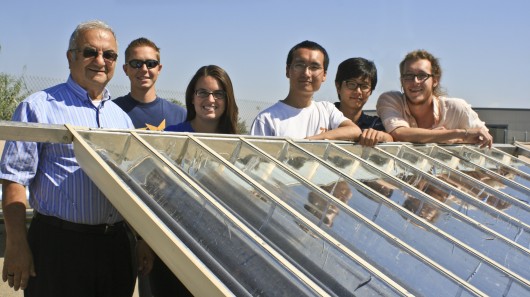Given that it typically gets hottest outside when the sunlight is most direct, it would make sense to have air conditioners that were powered by the thermal energy from solar rays. Unfortunately, collecting enough of that energy in a cost-effective manner can be challenging. Now, however, a team of University of California, Merced students have created a solar thermal collection system that is said to be significantly simpler, cheaper and more efficient than anything that’s come before.

The students were led by Professor Roland Winston, and their system uses what are known as External Compound Parabolic Concentrators (XCPCs). Each device concentrates sunlight onto a specially-designed collector tube, which converts that sunlight’s energy into heat. The combined solar heat from an array of these XCPCs can be fed into a building’s heating system, used to generate electricity, or to run an absorption chiller-style air conditioner – these generate cold air in a process that utilizes heat, as opposed to electricity created from heat.
The UC Merced system is simpler than many other solar thermal collectors, in that it is stationary – other systems turn to track the Sun throughout the day, which requires complex mechanisms and a source of power, plus it limits the locations in which they can be installed.
Because the system has such a wide field of view of the sky, it is also able to operate even on hazy days, scavenging sufficient heat even from indirect sunlight.
In tests of the technology, the system was reportedly able to reach a solar thermal efficiency of 60 percent at temperatures up to 400F (204C). “The efficiency of 60 percent refers to 60 percent of the sun’s irradiance being converted into ‘thermal’ energy” UC Merced’s Ron Durbin explained to us. “This is quite different than a photovoltaic system that converts 15-20 percent of the sun’s irradiance into electricity.”
Winston admits that many other scientists have doubted the UC Merced team’s claims, which is why they set up a demonstration. They are currently using an array of 160 XCPCs in two parallel rows, to run a 6.5-ton (5.9-tonne) “double-effect” absorption chiller in a mobile office trailer.
“We believe this is the first working system of its kind anywhere in the world,” said Winston. “For any application that requires process heat, the XCPC system is potentially a very cost-effective way to reduce conventional fuel consumption and greenhouse gases.”
German research firm Fraunhofer has also experimented with solar-powered absorption chillers for refrigerating perishable foodstuffs in Tunisia and Morocco.
Source: gizmag
 Follow
Follow